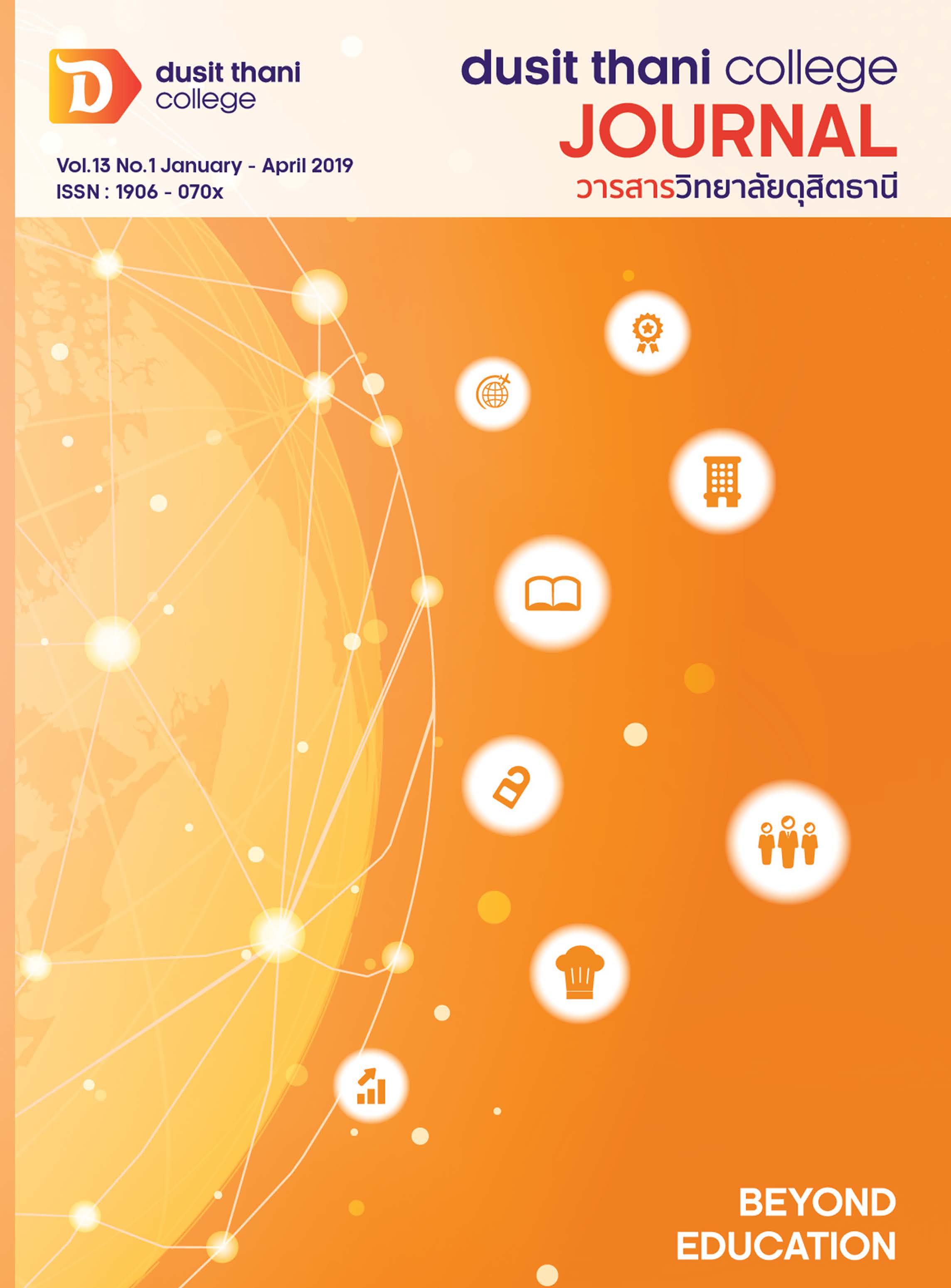The Study of Tourism Resources in Banphe Sub-district, Muang District, Rayong Province which Serve the Need of Chinese Tourists
Main Article Content
Abstract
The study had 3 purposes including: 1. to study various types of tourism resources to develop to be tourist attraction, at which Chinese tourists spend more time 2. to study the needs of Chinese tourists in visiting tourism resources 3. to increase the income of the entrepreneurs and local people. Sampling used in this research can be divided into 2 groups: 40 officers in Rayong tourist office, Ban Phe sub-district administrative organization (SAO), tour operators, local philosophers, and other related entrepreneurs; and 100 Chinese tourists who come to visit Ban Phe sub-district. The tools used in this research are an interview and a focus group. After the data required were collected, the researcher then analyzed the data and applied it to develop the existing tourist attractions and propose the project to construct new tourism resources to fulfill the need of Chinese tourists. The findings are 1. There are 2 existing tourist attractions: 1) Samruat Nava Chinese Shrine, an ancient shrine since the time of Chinese merchant ships, 2) local market and should construct 1 new tourist attraction in Ban Phe sub-district which is Suntornphu, the great Thai poet in Thai Pavilion, and Li Bai, the great Chinese poet in Chinese Pavilion, 2. Chinese tourists are interested in spending more times at Samruat Nava Chinese shrine for their safe journey and spare time for purchasing products at local market and visit new monuments constructed to express a profound relationship between Thai and Chinese. 3. The related entrepreneurs and local people will receive more income from their services and products in the local market, Samruat Nava Chinese shrine according to the number of tourists’ statistic and number of tourists’ forecast. Ban Phe sub-district, therefore, should improve their existing attractions and construct a new one. And lastly, they should encourage a larger number of entrepreneurs and local people to take care of the mentioned attractions, improve and do more transactions in order to increase the income of the community.
Article Details
Article Screening Policy
- All research and academic articles to be published must be considered and screened by three peer reviews in the relevant field / article.
- All articles, texts, illustrations and tables published in the journal are the personal opinions of the authors. Editors don't always have to agree. And no responsibility whatsoever is the sole responsibility of the author.
- The articles to be published must never be published. Where did you first publish? And not in the consideration of other journals If the audit found that there has been a duplicate publication It is the sole responsibility of the author.
- Any article that the reader sees as being plagiarized or impersonated without reference. Or mislead the work of the author Please let the journal editor know it will be your greatest blessing.
References
2. Bharasakul, L. 2015. The Motivations and the Attitudes Affecting the Satisfaction Level of Chinese Tourist’s Visiting Thailand. Bangkok: Dhurakij Pundit University.
3. Chittangwattana, B., (2006). Tourism Business. Bangkok: Press and Design.
4. Department of Tourism. (October 22, 2017). The Foreign Tourists Statistic Arrive to Thailand. Retrieved from http://marketingdatabase.tat.or.th/ewt_w3c/ewt_news.php.
5. Department of Tourism. (October 22, 2017). The Arrival of Tourists to Rayong Province. Retrieved from http://tourism.go.th/farms/uploaded/00Statistic/2017/Internal/Profile/East/Profile/Rayong.pdf.
6. Jetanon S. (2014). Promoting Tourism for Chinese Tourist in Bangkok. Faculty of Humanities and Social Sciences. Bangkok: Rachabhat Suan Sunanda University.
7. Juthaporn, S., (2013). Introduction to Tourism Industry Unit1-7. 2nd Edition. Teaching Literature. Bangkok: Sukhothaithammathirat University.
8. Koh-Samed.org. (October 25, 2017). Travel to Koh Samed. Retrieved from http://www.Koh-Samet.org/ go -to-samet.htm.
9. Mason, Peter. (2005). Tourism impacts, Planning and Management. Oxford:
Butterworth-Heinemann.
10. McIntosh, Robert W. and Goedner, Charles R. (1986). Tourism Principle, Practices, Philosophies. 5rd ed. New York: John Wiley and Sons, Inc.
11. Nitinavakorn, P. (2002). Tourists’ Behavior of People Republic of China Tourists in Thailand. Independent Study of Master of Economic. Bangkok: Sukhothaitahmmathirat University.
12. Ratintorn S. (2012). The Push and Pull Factors Affecting to the Decision of Chinese Tourists in Choosing Thailand as Their Destination. APHEIT Journal 18(1).
13. Samithikrai, C., (2011). Consumer Behavior. 2nd ed. Bangkok: Chula Press.
14. Suphatatatarn, K. (2005). The Tourist Behavior Analysis of Chinese Tourists in Thailand. Master of Economic Program. Bangkok: Thai Chamber of Commerce University.
15. Techataweewan, S. (2002). Tourist Behavior. Khonkaen: Khonhaen University.
Tourism Authority of Thailand. (January 18, 2016). Rayong Province. Retrieved form http://thai.tourism thailand. org.
16. Tourism Authority of Thailand. (January 22, 2016). Tourism Situation of Rayong Province. Retrieved from http://www.2tat.or.th.
17. United Nations World Tourism Organization. Definition of Tourism. (August 18 2017). Retrieved from http:// www.unwto.org.
18. Uttarak S., (2011). Factors Influencing Chinese Tourists’ Decision to Visit Thailand.
(Master Degree Thesis, Dhurakij Pundit University).
19. Wongmontha, S., (1999). Consumer Behavior. Bangkok: Theera Film and Sotext Co., Ltd.


